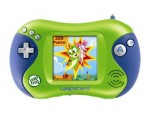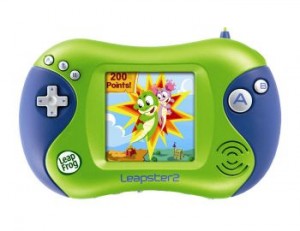Hardware Review: Leapster 2
 A long time ago, I was asked to review the Leapster handheld video game system from Leapfrog. It had recently been released to target the 4-8 year old bracket and I was supposed to check out some of the educational-oriented games that worked with the system. I was pleasantly surprised to find them both entertaining (well, for the right age group) and fairly educational. Since that time, I continue to be impressed at how Leapfrog manages to produce quality products that are both fun to play and contain educational components. Fast forward to the present, and Leapfrog now has a Leapster 2 system available. How does it stack up? Compatible with all previous Leapster games, it has a few hardware and software improvements that make getting the newer model a smart move for anyone looking to invest in one.
A long time ago, I was asked to review the Leapster handheld video game system from Leapfrog. It had recently been released to target the 4-8 year old bracket and I was supposed to check out some of the educational-oriented games that worked with the system. I was pleasantly surprised to find them both entertaining (well, for the right age group) and fairly educational. Since that time, I continue to be impressed at how Leapfrog manages to produce quality products that are both fun to play and contain educational components. Fast forward to the present, and Leapfrog now has a Leapster 2 system available. How does it stack up? Compatible with all previous Leapster games, it has a few hardware and software improvements that make getting the newer model a smart move for anyone looking to invest in one.
Why version 2?
Following the trends in cell phones, with Leapster 2, smaller is better. The original was solidly-built and could take a beating, but its large size was even a bit much for me to use with adult hands. It was best used by kids while sitting in their laps. This newer model is significantly smaller, and most kids in the target age range (4-8) could hold it freely in their hands. Smaller kids will still prefer it in their laps if used for longer periods of time. The new model also connects to the internet (via a computer). It doesn’t allow browsing of the internet, but it will let parents upload status updates of their child’s progress to the Leapfrog web site. More recent Leapster games keep track of a child’s development and will report it (when connected) to the web site. Parents can then visit the (password protected) web site for their child to monitor their progress. Connecting to the web site even allows users to download free games into the hardware. Through accomplishments completed on their Leapster, kids can earn rewards through the online site.

Durability
There are two main arguments for a Leapster system over other popular handheld systems (such as from Nintendo, Sony, or others). The most convincing is the handheld’s durability. The Leapster 2 is slightly smaller than the previous model but is still built like a tank. I’ve cringed to see my son drop it (admittedly only a couple feet) onto a tile floor with no damage whatsoever. That may not happen every time, but it feels well made and can take some good abuse. Even the touch pen used on the touch sensitive screen is nice and fat for little hands and is attached to console with a sturdy string. (My son has already lost two styli from my Nintendo handhelds and they’re not even his!) I try to discourage it, but my son often uses the string as a handle for the system when the stylus is inserted into its handy slot. Aside from the stylus/pen the buttons are easy to press, even the smaller ones that control lighting and shading (handy for sunny and late night car rides.) My biggest complaint about the system is related to the durability. The touch-screen is not always as responsive as I would like to see it. After a press or two doesn’t register, my son occasionally gets angry enough to start pounding on the screen with the pen (which absorbs the blows well) but the times I’ve given the system a spin I’ve sometimes encountered the same problem.
Software
Any handheld like this will live or die by its software selection. With the entire library of original Leapster titles available, the Leapster 2 starts in a good position. Most current Leapster titles can be played on either system, but players with Leapster 2 can take advantage of the Leapfrog Learning Path (the online progress tracking feature). There are even a few default games and activities that are built-in (and a couple that can be downloaded) that are pretty good. My son enjoys the built-in painting program in particular. What I like about most Leapster titles is their reasonable educational content. The learning isn’t presented with a hammer, but is integrated into the games and puzzles. Are all the games great and slam-dunk hits? No, but the quality is generally good, far better than the typical educational titles on other systems that are frequently boring or not educational at all. To be honest, one of the best things Leapfrog has going for them are high profile brand licenses. Kids who are really into Cars, Dora, Star Wars, Disney, and the like will find a game that appeals to their favorites.

Price
Coming in at around $60 for the base unit, $80 if you buy some sort of game bundle, the Leapster is less expensive than most electronic handhelds. Although the technology is somewhat behind other handheld models, how much computer power and graphic elegance does one need for quality high-contrast colorful edutainment titles for this age group? the rugged build While a brand-conscious older child will probably not be satisfied with a Leapster if they specifically want something else, younger gamers (Leapster’s target audience) who just want a handheld type toy will be very satisfied with the handheld and its more age-appropriate titles. Most games come in at $20 or less which puts the software clearly on the less expensive end of the software spectrum.
Age appropriateness/Kid Factor
Made for kids ages 4 to 8, this system is all about the young ones. There are the occasional superhero or other “edgier” titles out there but everything is sanitized for this age range. As shown by my 3 year old son, some of the titles can be played younger, and due to the positioning of the product I’d recommend a more traditional handheld if your son or daughter was pushing 8 or more. Sure, there are some games that will still get their attention, but a different handheld (such as a Nintendo DS, but with an eye towards some of the more educational games) will pay off in the long run. For kids on the younger end (4-6 or so) this is the handheld to get due to its rugged build and quality educational software selection.
Conclusions
For the target age group, there’s not really anything better out there. Its durability beats out any other system for 4-6 year olds, as unsupervised they’d have a good chance of breaking any more high-end handheld. The games will still have some appeal on the older age range (6-8), giving the unit some continued used. However, I would be wary of buying the unit for kids on the older end as they are much more likely to be yearning for the higher-end systems and their flashy big-name titles.





December 2nd, 2009 at 6:48 am
When I first saw LeapFrog’s products at E3 many years ago, I knew they’d have a hit on their hands. –Cary
December 5th, 2009 at 10:27 pm
Out of curiosity, if they have the original Leapster, is there any real incentive to upgrade? Are there games that only work on the Leapster 2?
December 6th, 2009 at 10:33 am
Whoops. I meant to be more clear about that in the article. I know of no games that will not run on the original. I think there are just some things that aren’t accessible in a given game (mostly dealing with the online reporting and some downloads).
If you already have the basic unit, unless you really want a smaller profile system, I wouldn’t bother upgrading. If you’re shopping for a new vs used one, I’d lean toward the newer version unless the price difference was too steep. (I really like the smaller size of the newer unit…)
July 3rd, 2010 at 12:34 am
Wireless speakers give you the freedom to move your music to where you want it to be without the hassles of cables. Planning to have a party outside? Don’t move your whole entertainment system outside while you can make use of outdoor wireless speakers which can move right along with the party.
=====
Useable Technology